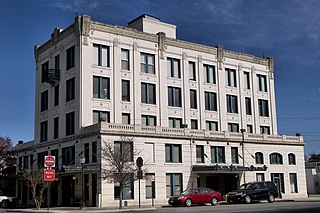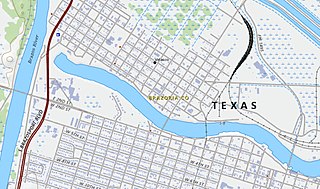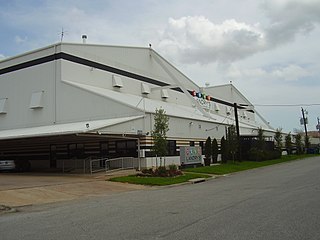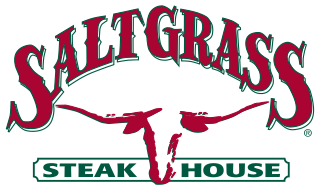
The San Marcos Mill Tract is a historical tract of land located in San Marcos, Texas. It is recognized as a historic place by the Texas Historical Commission. [1]

The San Marcos Mill Tract is a historical tract of land located in San Marcos, Texas. It is recognized as a historic place by the Texas Historical Commission. [1]
The tract is located on land that was granted to Juan M. de Veramendi in 1831.
The property was later purchased in 1844 by Edward Burleson, where he built the first dam on the San Marcos River, simultaneously providing power for a grist mill and sawmill. The tract was later used as a cotton gin, three different icehouses, a waterworks, and an electric power plant. The tract evolved into an industrial park, substantially impacting the local economy.
In more recent years, the tract has served as the site of various scenic restaurants overlooking the headwaters of the San Marcos River. Over the past several decades, these popular restaurants have included Pepper's at the Falls, Joe's Crab Shack, Saltgrass Steak House, and the current San Marcos location of Kerbey Lane Cafe, which originated in Austin, TX.

Lampasas County is a county located on the Edwards Plateau in the U.S. state of Texas. As of the 2020 census, its population was 21,627. Its county seat is Lampasas. The county is named for the Lampasas River.

Seguin is a city in and the county seat of Guadalupe County, Texas, United States. The population was 29,433 at the 2020 census, and according to 2023 census estimates, the city is estimated to have a population of 36,013.

San Marcos is a city and the county seat of Hays County, Texas, United States. The city is a part of the Greater Austin Metropolitan Area. San Marcos's limits extend into Caldwell and Guadalupe counties, as well. San Marcos is on the Interstate 35 corridor between Austin and San Antonio. Its population was 44,894 at the 2010 census and 67,553 at the 2020 census. Founded on the banks of the San Marcos River, the area is thought to be among the oldest continuously inhabited sites in the Americas. San Marcos is home to Texas State University and the Meadows Center for Water and the Environment.

York Steak House was a national chain of steakhouse restaurants in the United States. It was among several chains owned at the time by cereal manufacturer General Mills. By 1982, there were nearly 200 restaurants in 27 states from Texas to Maine. Though popular in the late 1970s and early 1980s, the majority of its locations shut down in 1989.

The Old San Antonio Road was a historic roadway located in the U.S. states of Texas and Louisiana. Parts of it were based on traditional Native American trails. Its Texas terminus was about 35 miles (56 km) southeast of Eagle Pass at the Rio Grande in Maverick County, and its northern terminus was at Natchitoches, Louisiana. The road continued from Texas through Monclova to Mexico City.

Velasco was a town in Texas, United States, that was later merged with the city of Freeport by an election conducted by eligible voters of both municipalities on February 9, 1957. The consolidation effort passed by a margin of 17 votes. Founded in 1831, Velasco is situated on the east side of the Brazos River in southeastern Texas. It is 16 miles (26 km) south of Angleton, and 4 miles (6.4 km) from the Gulf of Mexico.

Landry's, Inc., is an American, privately owned, multi-brand dining, hospitality, entertainment, and gaming corporation headquartered in Houston, Texas. Landry's, Inc., owns and operates more than 600 restaurants, hotels, casinos, and entertainment destinations in 35 U.S. states and the District of Columbia. The company also owns and operates numerous international locations. The company is owned by President & CEO Tilman Fertitta.
Taylorstown is a small community in Loudoun County, Virginia, built on the banks of Catoctin Creek and the surrounding hillside, about two miles (3 km) south of the Potomac River. First settled in 1734, it holds two of the oldest standing houses in Loudoun County, "Hunting Hill" and "Foxton Cottage", directly across the Catoctin Creek from each other.

Saltgrass Steak House is an American restaurant concept with more than 80 locations across the country. The company is based in Houston, Texas, and is wholly owned by Landry's, Inc.

North Uxbridge is a village and a post office in the town (township) of Uxbridge in Worcester County, Massachusetts, United States. The postal zip code is 01538. It is classified as a community or populated place located at latitude 42.088 and longitude -71.641 and the elevation is 266 feet (81 m). North Uxbridge appears on the Uxbridge U.S. Geological Survey Map. Worcester County is in the Eastern time zone and observes DST. North Uxbridge is located approximately 36 miles west-southwest of Boston, and 15 miles southeast of Worcester. The town meeting in 1885 set aside North Uxbridge as a "special district", since its population had exceeded 1000 people. North Uxbridge appeared as a separate Census tract in the 1960 census, with a population of 1882. In 2013, an Uxbridge DIY show, The Garage, with Steve Butler, went worldwide from Steve's garage in North Uxbridge.

La Villita Historic Arts Village is an art community in downtown San Antonio, Texas, United States. There are art galleries, stores selling souvenirs, gifts, custom jewelry, pottery, and imported Mexican folk art, as well as several restaurants in the district. La Villita connects to the San Antonio River Walk and its outdoor venue, the Arneson River Theatre. It is close to the Alamo, the Henry B. Gonzalez Convention Center, Rivercenter Mall, and HemisFair Park. It is within walking distance of most downtown hotels.

Jerusalem Mill Village is a living history museum that spans the 18th through early 20th centuries. One of the oldest and most intact mill villages in the U.S. state of Maryland, Jerusalem is located in Harford County, along the Little Gunpowder Falls River. It also serves as the headquarters of the Gunpowder Falls State Park. The site was added to the National Register of Historic Places on August 20, 1987. Also on the National Register of Historic Places and located nearby are Jericho Farm and the Jericho Covered Bridge.
Peach Point Plantation is a historic site located in Jones Creek, Brazoria County, Texas. It was a forced-labor farm and the homestead and domicile of many early Texas settlers, including Emily Austin Perry, James Franklin Perry, William Joel Bryan, Stephen Fuller Austin, and Guy Morrison Bryan. The land was operated as a working forced-labor farm producing cotton and sugar cane from 1832 until 1863.
Zodiac is a vanished Mormon settlement established in 1847 on the Pedernales River, located 4 miles (6.4 km) southeast of Fredericksburg, in Gillespie County, in the U.S. state of Texas. The area it was located on eventually converted to private acreage, and no trace of the settlement remains today. It was the first Mormon colony established by Lyman Wight in Texas. The second settlement was Mormon Mill in Burnet County in 1851, and his third and final settlement was Mormon Camp in 1854 in Bandera County. In 1936, Zodiac was designated a Recorded Texas Historic Landmark, Marker number 10133.

Travis County has had two locations named Montopolis. The first was during the Republic of Texas period north of the Colorado River. The second is today's Montopolis neighborhood in Austin, Texas south of the river. Located southeast of the city's urban core, today's neighborhood is in ZIP code 78741. Montopolis is bounded by Lake Lady Bird on the north, by Grove Street and the Pleasant Valley neighborhood on the west, to the south by Texas State Highway 71, and by U.S. Route 183 on the east. The southeast corner abuts Austin-Bergstrom International Airport. Montopolis is in City Council District 3.

The Guenther House is a restaurant, museum and store located at 205 E. Guenther Street in the King William neighborhood of the Bexar County city of San Antonio in the U.S. state of Texas. Currently operated by C. H. Guenther and Son. Inc., the home was originally built as a private residence in 1859 by Pioneer Flour Mills founder Carl Hilmar Guenther. It was listed on the National Register of Historic Places listings in Bexar County, Texas on October 11, 1990.

Saffold Dam at the Flores Crossing is a dam and man-made waterfall in the city of Seguin, Texas. Named for William Saffold, a Civil War veteran, a major landowner and local merchant. The dam was listed on the National Register of Historic Places on November 15, 1979.